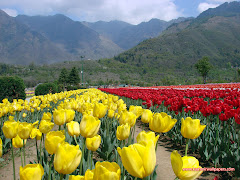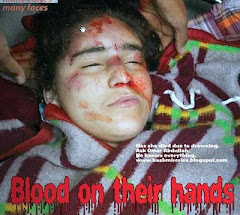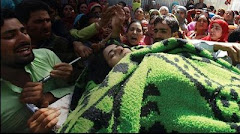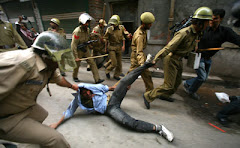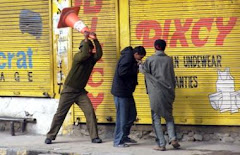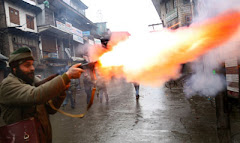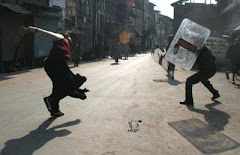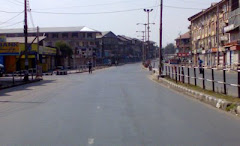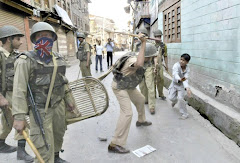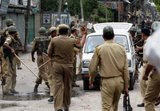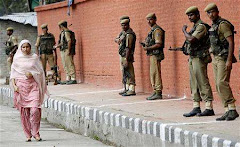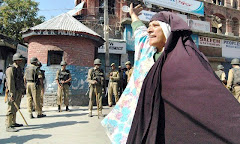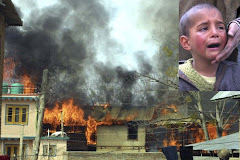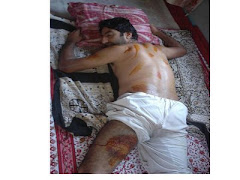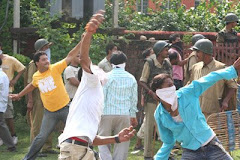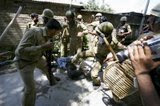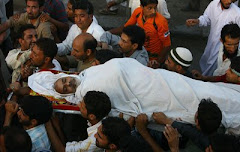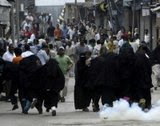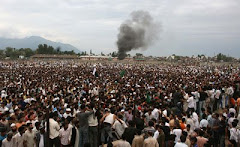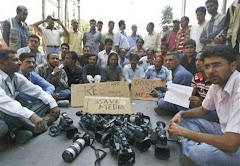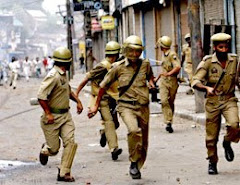India has been pursuing its policy of what the economists term as a "DEPENDENCE SYNDROME" in Kashmir. India has been funding us in a very tactful manner over the years. They invest in areas like hydroelectricity which will ultimately benefit none else than India itself or else in opening new Anganwadi Centres whose workers have to ultimately rely on centre for their petty salaries. Their game plan is to keep Kashmiris always dependent upon central funds. They don't let us stand upon our own feet, they don't let us generate our own income and income for our brethren too by opening our own manufacturing units. They provide us crores in the form of wages but nothing much for our industrialization and economic self-reliance. That is the reason why most of our youth are unemployed and craving for government employment because there are hardly any opportunities in private sector.
Here are a few details regarding various much hyped, high profile economic packages announced by the central govt for Kashmiris in the past. Present Prime Minister of India, Manmohan Singh, unveiled a Rs. 24,000 crore “package” for J&K in 2004. A huge chunk of the Rs 24,000 crore - totaling Rs. 18000 crore - was actually meant to be spent by the Government of India through National Hydro Power Corporation (NHPC) to “improve transmission and distribution (T&D) systems in the State. Out of the Rs 18000 crore a big chunk was spent on the construction of Uri II and Kishenganga Power Projects – both in the central sector. The remaining amount of Rs. 6000 crores was to be used for paying salaries of Anganwadi workers since the 2004 “package” had also envisaged creation of 24,000 new jobs including 14000 caretaker jobs of Anganwadi (ICDS) centres, 5000 jobs in CRPF and 5000 in India Reserve Battalion (IRB). Let us do not forget that the “package” provided for financial assistance for only one year for these jobs and from the second year it was the State government that has been paying for all these jobs.
Same has been the fate of Rs. 6165 crore “package” announced by India’s former Prime Minister – Mr. Vajpayee that included 287-km Udhampur-Srinagar-Baramullah rail line at a cost of Rs 3500 crore and Nimu Zangal-Padam-Darcha Road linking to Manali-Sarchu Road at a cost of Rs.195 crore. Remember the project was to be executed by the Border Roads Organisation (Ministry of Defence) and Ministry of Surface Transport for defence purposes. The basic problem with these packages is that they do not help create a decent industrial and services base in J&K which could raise jobs and also government’s tax revenues. Therefore the economic packages announced by the GOI from time to time have proved to be packages of deceit since they have in no way helped our economy grow but have rather proved to be a tool to reinforce Indian occupation in Kashmir.
On April 8th, 2008, President of the Associated Chamber of Commerce and Industry of India (ASSOCHAM) Sh. Venugopal N Dhoot while releasing the ASSOCHAM special publication on ‘Jammu & Kashmir: Striving for Industrial Revolution’ at a press conference held at Jammu urged the central government in presence of then Chief Minister of J&K, Ghulam Nabi Azad to extend a special package of Rs. 5000 crore to improve the necessary infrastructure so that investment flows towards Jammu and Kashmir fastens both in value and volumes from domestic and overseas industries. Dhoot requested the Union government, to allocate the suggested package to the state of Jammu and Kashmir through the Planning Commission. According to this study, the most promising areas in which Jammu and Kashmir can attract outside investments include food processing- agro-based industries, floriculture, handicrafts, leather processing and leather goods, besides sports, forest-based industry, processing of aromatic plants and herbs, pharmaceuticals based on herbs, bulk drugs, hosiery and made-ups. The state also offers immense business opportunities in hydropower generation, handloom and handicraft exports, gems & jewelry and development of tourism. Given the rich heritage and availability of required skills in gems & jewellery, the state offers to be a promising hub for the industry.
Particulalry in reference to hydro potential, Jammu and Kashmir’s hydel potential is estimated to be about 15,000 megawatt of which only four per cent has been harnessed as the state only generates over 600 megawatt of hydro power. The Central Electricity Authority has already approved two hydroelectric power generating projects. The state has also cleared the setting up of about 12 mini hydel plants. What is needed is their immediate execution. The study projected investments in about more than a dozen identified areas, job opportunities to the extent of 25 lakh youths with export potential of Rs 13,000 crore by 2012. In food processing and agro based industries, investment potentials for 2012 is estimated to be Rs.3000 crore with its export potential of Rs.2000 crore. This sector alone is going to create livelihood for state’s three lakh people. The Kashmir valley also holds the opportunity to become a destination for adventure sports like trekking, mountaineering, water skiing and river-rafting. While places like Ladakh will be the ideal destination for trekking and mountaineering, rivers like Beas, Indus, Sutlej and Kali Ganga will be best suited for river rafting, the study reveals further. It is also recommended that the state should create a Jammu & Kashmir Export Promotion Force to tap the potential international markets by way of opening up of various strategic and marketing offices in the metropolis and industrial cities of India and world to promote its exports. The state has the potential to export Rs 13,000 crore worth of goods in the next five years. The potential sectors for export include processed food, fruit juice concentrate, leather products, handicrafts, and silk, herbs and herbal products, honey, welding electrodes, pesticides, floriculture, sports goods, forest based products, gems and jewellery, and electronics.
Jammu and Kashmir stands amongst the top five smaller states in various developmental and infrastructural indicators and holds third rank in electricity generation, labour cost per worker, and number of technical institutes. It also ranks fourth in infrastructure expenditure amongst the smaller states and has fifth rank in foreign direct investment (FDI) inflows and number of primary schools in the state. Whereas the state has the sixth rank in female labour participation, has seventh rank in fiscal deficit. It ranks eigth in total investments, highest number of industrial workers. According to per capita SDP growth, the state ranks eleventh, and growth in manufacturing employment it ranks thirteenth. By reviving the state’s tourism industry, it can re-establish unemployed youths, through creation of infrastructure facilities such as modern bus and rail services and if feasible air services also. Foreign and domestic tourists could be attracted for the picturesque beauty, and the large natural lakes, snow clad mountains surrounded by thickly populated pine forests could make Jammu and Kashmir a prime tourist destination in the world. The state government should adopt the methods of successful tourism destinations like Switzerland and other European union countries.
Agriculture is predominant sector in the economy of Jammu and Kashmir. Directly and indirectly, it supports about 80 per cent of the population besides contributing nearly 60 per cent of the state revenue. Further, state government should plan for higher production and productivity of each major cereal in order to achieve an annual agricultural growth rate of three to four per cent. The state government should also provide adequate training to farmers about the use of modern technology in agriculture. One important aspect for the increase in productivity is the adequate credit to the farmers, which is not significant in the state. The state should initiate this through the nationalised banks, so that the cultivators get adequate finance on credit for agricultural development. The state government should also adopt a suitable crop insurance scheme. By adopting these initiatives, it would further strengthen the confidence of the farmers. The government should also provide infrastructure to private investors to set up agriculture and biotechnology research institutes as the state has the potential for the cultivation of medicinal plants for natural health care. The state has extensive inland water bodies, particularly in the valley, which provide excellent habitat for almost any kind of temperate fish.
To counter the monster of unemployment, our higher education needs to be more professional and industry oriented. We have to enable our pupil to earn degrees that are saleable in the free economy markets and capable of facing the challenges of globalization. Our MCAs and MBAs get some or the other job, but most of our M.Scs M.Coms and M.As suffer on account of lack of professional skills. We need to impart graduate and post-graduate level professional courses in our higher education institutions like colleges and universities. Unplanned explosion of education and opening up new colleges and universities without adequate infrastructure, faculty and other facilities in place, that has been the hallmark of the previous regime has to be done away with. Most importantly India has to shun its policy of "Dependency" in Kashmir and allow, promote and foster liberal industrialization besides entrepreneurship development. Entrepreneurship development courses have to be offered to our general science, commerce and arts graduates in sectors like tourism developement, herbal drug cultivation, food processing, electronics and communication technology, modern agricultural, floricultural and horticultural practices etc. We need to open more and more institutes of technology and impart technical courses at grad and post grad level to our budding entrepreneurs.
Present government has to develop an ambience of industrial development and entrepreneurship. It has to get rid of hurdles and hiccups existing at present in the way of entrepreneurship development. It has to lure national and international investors and open up vistas for their manufacturing bases in the valley. That is the key to solving our problem of unemployment. All other measures like economic packages, recruitment in police forces and other depts will be just a cosmetic treatment to the problem. The gross domestic product (GDP) or gross domestic income (GDI) is one of the measures of national income and input for a given country's economy. GDP is defined as the total cost of all finished goods and services produced within the country in a stipulated period of time (usually a 365-day year). It is sometimes regarded as the sum of profits added at every level of production (the intermediate stages) of all final goods and services produced within a country in a stipulated timeframe, and it is rarely given a monetary value.
At the state level, the growth performance of the state economy is measured using Gross State Domestic Product (GSDP), which is the total income of the economy. The per capita income in J&K state is estimated at Rs 16,000. This level of per capita income is lower than the All India level of Rs 23,000. The gross state domestic product (GSDP) stood at $5.57 billion in 2005-06 amounting to about 5.5 billion dollars. The share of the state's income (GSDP) in total national income (GDP) is a meager 0.70% which desperately needs to grow up a lot in all three sectors – primary (comprising agriculture and livestock, forestry and logging, fi shing, mining and quarrying), secondary (comprising manufacturing, construction and electricity, gas and water supply) and tertiary (comprising trade, hotels and restaurants, transport, storage and communication, financial services, real estate and related services, public administration and other services).
For a greater insight about the avenues where vast employment opportunities exist in the Kashmir valley which if fostered and promoted can greatly address our problem of unemployment, it is suggested to see the suggestions made by FICCI as the first comment this post.

